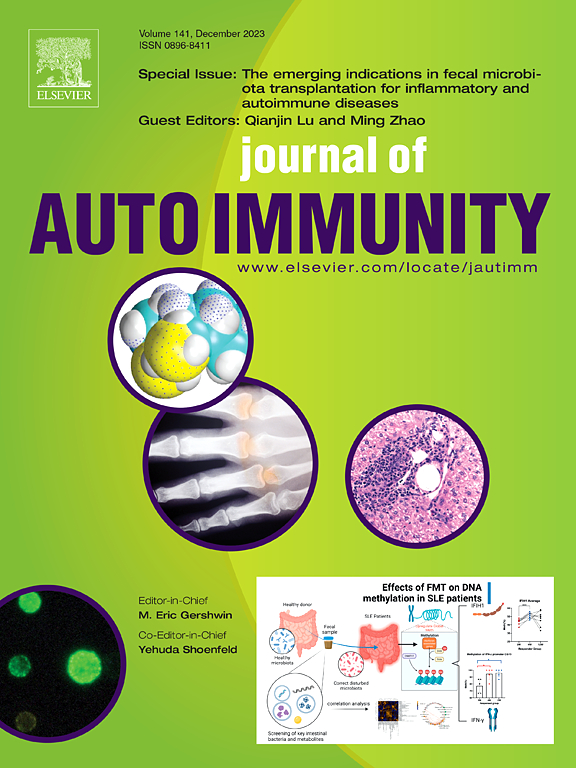通过 RNA 免疫沉淀与大规模并行测序扩展系统性硬化症相关自身抗体的范围
IF 7
1区 医学
Q1 IMMUNOLOGY
引用次数: 0
摘要
目的系统性硬化症(SSc)相关自身抗体是广泛使用的诊断和预后生物标志物。本研究旨在开发一种基于 RNA 免疫沉淀(RNA IP)与大规模平行测序相结合的检测 SSc 中抗核糖核蛋白自身抗体的新方法。方法收集了307名SSc患者的血清样本和临床数据,其中57个样本采用了结合RNA IP和大规模平行测序(RIP-Seq)的新方案进行分析。结果在 57 例 SSc 患者的 RIP-Seq 鉴定出的 30,966 个不同的 RNA 分子中,最终选出了 197 个。这些RNA分子包括之前通过RNA IP鉴定出的所有RNA分子,发现这些RNA分子几乎只在与相应RNA分子相关的自身抗体阳性样本中表现出高计数,这表明RIP-Seq技术具有很高的灵敏度和特异性。C/D box snoRNA是鉴定出的最丰富的RNA类型。不同患者检测到的 C/D box snoRNA 的免疫沉淀模式各不相同,可能与不同的临床表型有关。此外,还发现了其他核糖核蛋白,它们可能是以前未曾描述过的 SSc 相关自身抗体的潜在靶标。这些核糖核蛋白包括H/ACA盒snoRNPs、拱顶复合体、线粒体tRNA合成酶和7SK snRNP。该方法成功鉴定了与已知被SSc相关自身抗体靶向的核糖核蛋白相关的RNA分子,验证了该检测方法和分析策略。此外,这种方法还发现了与核糖核蛋白相关的RNA分子,而这些核糖核蛋白以前并未被确定为SSc患者血清的靶标,这表明这种疾病有可能出现新的自身抗体候选者。本文章由计算机程序翻译,如有差异,请以英文原文为准。
Expanding the landscape of systemic sclerosis-related autoantibodies through RNA immunoprecipitation coupled with massive parallel sequencing
Objectives
Systemic sclerosis (SSc)-related autoantibodies are widely used diagnostic and prognostic biomarkers. This study aimed to develop a new assay for detecting anti-ribonucleoprotein autoantibodies in SSc based on RNA immunoprecipitation (RNA IP) coupled with massive parallel sequencing.
Methods
Serum samples and clinical data were collected from 307 SSc patients. Among these, 57 samples underwent analysis using a new protocol that combines RNA IP with massive parallel sequencing (RIP-Seq). Filtering strategies and statistical outlier detection methods were applied to select RNA molecules that could represent novel ribonucleoprotein autoantigens associated with SSc.
Results
Among the 30,966 different RNA molecules identified by RIP-Seq in 57 SSc patients, 197 were ultimately selected. These included all RNA molecules previously identified by RNA IP, which were found to exhibit high counts almost exclusively in samples positive for the autoantibodies associated to the corresponding RNA molecule, indicating high sensitivity and specificity of the RIP-Seq technique. C/D box snoRNAs were the most abundant RNA type identified. The immunoprecipitation patterns of the detected C/D box snoRNAs varied among patients and could be associated with different clinical phenotypes. In addition, other ribonucleoproteins were identified, which could be potential targets for previously undescribed SSc-related autoantibodies. These include H/ACA box snoRNPs, vault complexes, mitochondrial tRNA synthetases, and 7SK snRNP.
Conclusion
A novel RIP-Seq assay has been developed to detect autoantibodies targeting ribonucleoprotein complexes in SSc patients. This method successfully identified RNA molecules associated with ribonucleoproteins known to be targeted by SSc-related autoantibodies, validating both the assay and the analysis strategy. Additionally, this approach uncovered RNA molecules associated with ribonucleoproteins that were not previously identified as targets of SSc patients’ sera, suggesting potential new autoantibody candidates in this disease.
求助全文
通过发布文献求助,成功后即可免费获取论文全文。
去求助
来源期刊

Journal of autoimmunity
医学-免疫学
CiteScore
27.90
自引率
1.60%
发文量
117
审稿时长
17 days
期刊介绍:
The Journal of Autoimmunity serves as the primary publication for research on various facets of autoimmunity. These include topics such as the mechanism of self-recognition, regulation of autoimmune responses, experimental autoimmune diseases, diagnostic tests for autoantibodies, as well as the epidemiology, pathophysiology, and treatment of autoimmune diseases. While the journal covers a wide range of subjects, it emphasizes papers exploring the genetic, molecular biology, and cellular aspects of the field.
The Journal of Translational Autoimmunity, on the other hand, is a subsidiary journal of the Journal of Autoimmunity. It focuses specifically on translating scientific discoveries in autoimmunity into clinical applications and practical solutions. By highlighting research that bridges the gap between basic science and clinical practice, the Journal of Translational Autoimmunity aims to advance the understanding and treatment of autoimmune diseases.
 求助内容:
求助内容: 应助结果提醒方式:
应助结果提醒方式:


